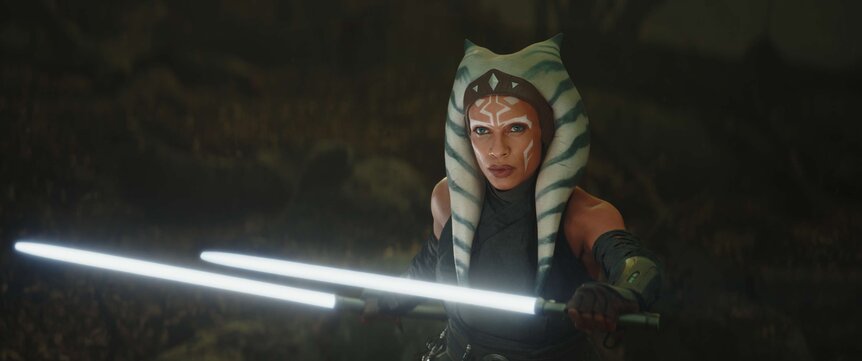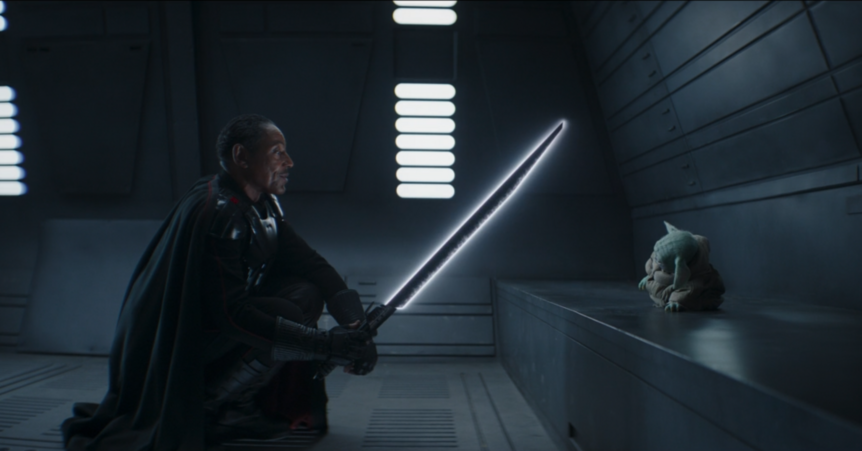Create a free profile to get unlimited access to exclusive videos, sweepstakes, and more!
Lightsaber colors, ranked
Mace Windu's purple lightsaber made its debut 20 years ago today. How does it compare to red, blue, green, and more?

First, there were only two lightsaber colors. Heroic Jedi used blue blades while those on the Dark Side used red. Then, after Luke Skywalker lost his lightsaber in The Empire Strikes Back, he forged a new, verdant green lightsaber in Return of the Jedi. And, 20 years ago today, Attack of the Clones introduced another lightsaber color when Mace Windu unveiled his purple weapon.
Although red, blue, and green remain the three most common lightsaber colors in that galaxy far, far away, the purple lightsaber is one of a handful of one-off lightsaber hues that have appeared in the movies since then. Since that purple lightsaber is two decades old, it seems a fine time to rank all the lightsaber colors. Please note that this ranking only includes lightsabers that have appeared in the movies or the live-action Disney+ TV shows, so no Expanded Universe/Legends stuff, and no video games or comics.
7. Purple
There’s no real reason why Mace Windu, among all the countless Jedi we see on screen over the course of the prequel trilogy, should have his own special lightsaber color. The behind-the-scenes explanation was that Samuel L. Jackson, who played the Jedi master, wanted his lightsaber to look special and pop out compared to the rest of the Jedi during Attack of the Clones' big battle scene, and George Lucas obliged his request to have a purple weapon. You can attempt to give the purple lightsaber more meaning with retroactive continuity (“Mace Windu used the Form VII or ‘Vaapad’ lightsaber fighting style which tapped into the Dark Side, so it makes sense his blade would be a combination of blue and red”) but it doesn’t really make up for the fact that the purple lightsaber feels like — and always was — an unnecessary bit of flair.
6. Yellow
We don’t see much of Rey’s yellow lightsaber when she briefly ignites the new blade at the very end of The Rise of Skywalker, which largely accounts for its low ranking in this list. (Well, that and the fact that it appears in The Rise of Skywalker.) Rey’s yellow blade doesn’t have much of a chance to make an impression, but thematically it carries more resonance than Mace Windu’s needlessly purple lightsaber. Rey — despite, ugh, being a Palpatine who adopts the last name “Skywalker” — is supposed to represent something new in the galaxy. A brand-new lightsaber color, one that’s a combination of the two common Jedi lightsaber colors (blue and green) but distinct from them, makes sense for Rey. Again, though, the impact of this yellow blade is lessened by its limited screen time and the way the movie contradicts both itself and the movies that came before it.
5. Green
Originally introduced to the series because another blue lightsaber would’ve been harder to make out against Tatooine’s cloudless sky in the opening of Return of the Jedi, green lightsabers would go on to become very common amongst the Jedi. It’s a fine color, but it lacks clarity of purpose compared to the blue variety. Blue and red are both primary colors, and when blue and red lightsabers clash, there’s a clear, primal distinction of good versus evil. Green is a secondary color, and as such it feels secondary and not as neat. Also, there can be a bit of an unintentional Christmas vibe when green and red lights flash.
4. White
In addition to being a possible nod towards the earliest concepts for lightsabers (originally white lazerswords that were far more commonplace in early Star Wars drafts), Ahsoka Tano’s twin blades are full of meaning. Although they are white because they are crystals that have been purified from the corruptive influence of the Dark Side that turned them red, Ahsoka’s white blades symbolize much more than just “purity.” As with Rey’s yellow lightsaber, they signify something new, as they’re the weapons that Ahsoka adopts when she leaves the Jedi order. In that way. Her weapons are free of the influence of both the Dark and the Light, but they are still quite complex, as is befitting a hue that’s the combination of all colors on the spectrum in one. The white blades may look deceptively simple and clean, but they’re all about contrast.
3. Black
It almost doesn’t seem fair to rank the one example of a black lightsaber, the Darksaber, with all the other lightsaber colors, because the Darksaber isn’t really a lightsaber. Or, it is, but it is so different from other lightsabers in appearance (it’s shorter and has a defined edge and point like a real sword rather than just being a glowing beam) and in lore (it’s a single ancient weapon that carries immense weight in Mandalore history and culture). Still, without getting too deep into the weeds, it’s hard to deny that the Darksaber is a dope weapon and the visual of a crackling photo-negative sword is extremely cool.
2. Blue
The first lightsaber we see in the franchise is still hard to beat. It’s clear, from the moment Luke first ignites his father’s weapon, that it is indeed “an elegant weapon for a more civilized age.” As mentioned earlier, blue is a primary color, but it is also what’s known in color theory as a “cool” color. The Jedi and others who serve the Light Side of the Force are powerful, yes, but there is an innate calmness, a collectedness, a coolness about them. Blue lightsabers are not overly complicated because they don’t need to be. They belong to the good guys.
1. Red
You hate to see the bad guys win, but the preferred color of the Dark Side — the only color they use, Anakin’s initial fall in Revenge of the Sith when he was still using his old blue lightsaber and, arguably, the Darksaber, excepted — has to be number one. Red, a primary color and a warm one, feels similarly primal as the cooler blue, only it also evokes blood, fire, and warning lights. The ignition of a single red blade in the shadows (or two, if you’re Darth Maul) is a potent signifier. This weapon and the person who wields it are dangerous and evil.
































